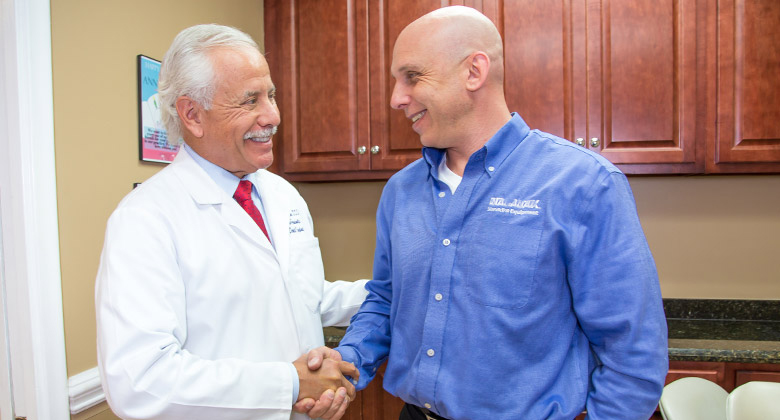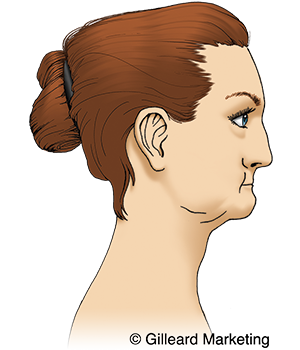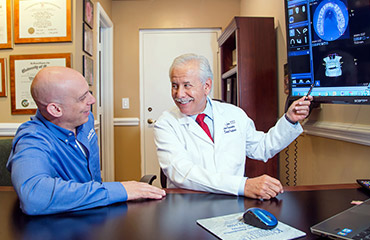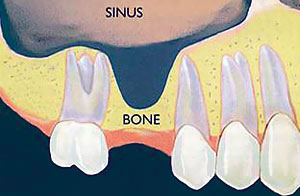Bone Regeneration and Sinus Lifts in Tamarac

We offer expert bone regeneration using efficient, minimally invasive techniques.
Highly Skilled Regeneration of Lost Bone
- Expert Bone Grafting Specialist
- What Causes Bone Loss
- How Bone Grafting Works
- Advanced Technology for Minimally Invasive Treatment
- The “Sinus Lift” Bone Graft for Upper Back Teeth
Your teeth are anchored in sockets on a platform of bone in your upper and lower jaws called the alveolar ridge. Strong connective tissues and bone firmly support your teeth and keep them stably in position.
For various reasons, the bone supporting the teeth can dissolve, causing tooth support to be compromised. This can cause a variety of oral health problems, such as painful chewing and tooth loss. It can also be a barrier to placing dental implants, as dental implants need a certain amount of bone support to be stable.
Fortunately, Dr. Levine is able to regenerate lost bone and preserve your teeth and jaw with modern bone grafting techniques.
Expert Bone Grafting Specialist

Dr. Levine is a skilled expert in bone regeneration.
Dr. Levine has been practicing periodontics since 1973 and is a highly skilled and experienced expert in bone regeneration. In addition to serving patients in private practice, he has taught bone grafting and other periodontal procedures as a faculty member at the University of Florida, Nova Southeastern University and Broward College. He instructs fellow practitioners on periodontics as a continuing education provider for Florida dentists.
Dr. Levine keeps himself current with the latest advances in bone grafting through extensive continuing education. He has incorporated new developments in digital diagnostics, minimally invasive techniques, cell regeneration and dental laser technology to provide the highest-quality and most comfortable bone grafting treatment possible.
What Causes Bone Loss
Below are the main causes of bone loss in the jaw:
- Gum disease—Gum disease is bacterial infection and inflammation of the gums that can result in loss of bone. As the disease becomes more severe, bone loss worsens until tooth support is minimal or gone altogether. Teeth eventually become loose or fall out.
- A missing tooth—The bone in your jaw needs the stimulation from regular biting and chewing pressure to maintain its volume and density. When a tooth is missing, that pressure is gone and the bone gradually dissolves.
- A misaligned tooth—A tooth can be positioned in such a way that it does not make contact with the tooth in the opposing arch when you bite down. This can severely reduce the biting and chewing pressure needed to maintain bone volume around the tooth and can lead to bone loss.
- Tooth injury—Injury to a tooth can cause misalignment or lead to an infection. Each of those can lead to bone loss around that tooth.
- Jaw infection—Tumors and infections that are not the result of gum disease sometimes develop in the bone tissue and can lead to bone loss.
Wearing dentures accelerates the rate of bone loss
 When teeth are missing, dentures do not supply the stimulation necessary to maintain the volume and density of bone in your jaw. In fact, the type of pressure exerted by dentures accelerates the rate of bone loss and wears away the ridges of bone that provide tooth support. As the bony ridge dissolves, the jaw loses height and thickness, eventually resulting in a “collapsed” facial look.
When teeth are missing, dentures do not supply the stimulation necessary to maintain the volume and density of bone in your jaw. In fact, the type of pressure exerted by dentures accelerates the rate of bone loss and wears away the ridges of bone that provide tooth support. As the bony ridge dissolves, the jaw loses height and thickness, eventually resulting in a “collapsed” facial look.
It is this bone loss that causes dentures to repeatedly become loose and need regular refitting. A poor fit causes gum sores and can make chewing painful.
How Bone Grafting Works
Dr. Levine places bone grafting material into the space where bone is missing to regenerate new bone tissue. The graft material itself does not actually form into new bone. It stimulates the growth of new bone and acts as a scaffold, or platform, around which the new bone can grow. As new bone tissue fills the space, the graft material harmlessly dissolves and is absorbed by the body.
Advanced Technology for Minimally Invasive Treatment

Dr. Levine uses 3D imaging for accurate diagnosis and treatment planning.
Dr. Levine uses high-tech diagnostics, advanced procedures and laser technology to provide bone grafting that is minimally invasive, efficient and faster-healing.
Cone beam 3D CT scanner for accurate diagnosis and planning
Our state-of-the-art cone beam 3D CT scanner provides 3D, 360-degree views of your teeth and jawbone. These images can be viewed from any angle and magnified to show Dr. Levine the exact bone levels around your teeth. He is able to plan bone grafts with great accuracy and perform the grafting procedure efficiently.
S.M.A.R.T. Minimally Invasive Bone Grafting

S.M.A.R.T. or subperiosteal minimally invasive aesthetic ridge augmentation is available to predictably manage complex cases in the esthetic zone. It was developed by Dr. Ernesto Lee in Philadelphia.
It is a simplified and efficient alternative to hip grafts, block grafts and traditional augmentation procedures, while avoiding soft tissue defects and loss of papillae. It is useful to treat challenging cases including widening of the ridges, bone loss around implants and vertical augmentations. Laparoscopic principles and special instruments are used to achieve predictable results, with less discomfort, swelling and fewer complications.
Dental lasers to eliminate infection and stimulate healing
 Advanced dental lasers are utilized disinfect the area where the graft is to be placed and, if needed, to gently reshape the existing bone in preparation for a bone graft. The laser eliminates the need for scalpels or other invasive instruments and makes the procedure faster and much less invasive.
Advanced dental lasers are utilized disinfect the area where the graft is to be placed and, if needed, to gently reshape the existing bone in preparation for a bone graft. The laser eliminates the need for scalpels or other invasive instruments and makes the procedure faster and much less invasive.
Another type of laser is used to perform low-level laser therapy on the graft site after the bone graft is placed. The laser energy stimulates healing and promotes regeneration of new bone. It also reduces postoperative swelling and discomfort.
Ultrasonic surgery unit to precisely sculpt bone
We have an ultrasonic surgical device Dr. Levine uses for sculpting bone during bone grafting procedures. The device generates a controlled microvibration that precisely carves bone but does not affect any of the surrounding soft tissues. This is a more accurate and less invasive method than bone modification performed with traditional surgical implements.
The “Sinus Lift” Bone Graft for Upper Back Teeth
The sinuses are large cavities above the back teeth in your upper jaw. If you lose one of these back teeth, bone loss occurs in the tooth socket. This may cause the floor of the sinus cavity, which lies directly above the socket, to sink. A sunken sinus floor can make the bone too shallow to support the full length of a dental implant.
If the bone around a rear upper tooth is found to be too shallow to place the implant, bone graft material will be placed along the floor of your sinus cavity. This will generate new bone and provide the added bone depth required for an implant to be anchored securely. This type of bone grafting procedure is known as a sinus lift.
To make an appointment, call 954‑722‑1100 or click here to request an appointment online.


